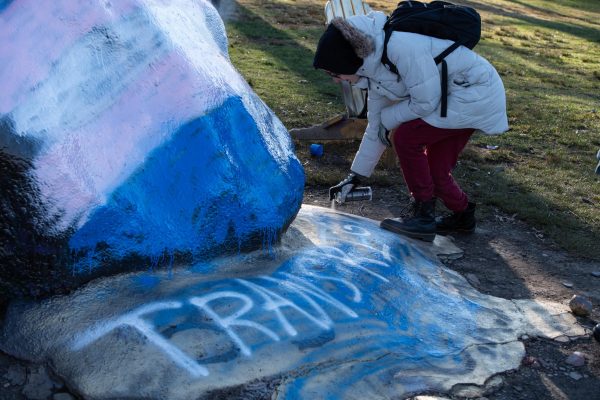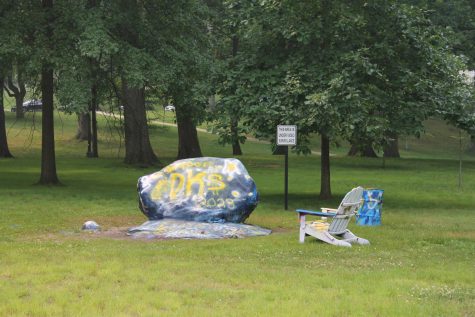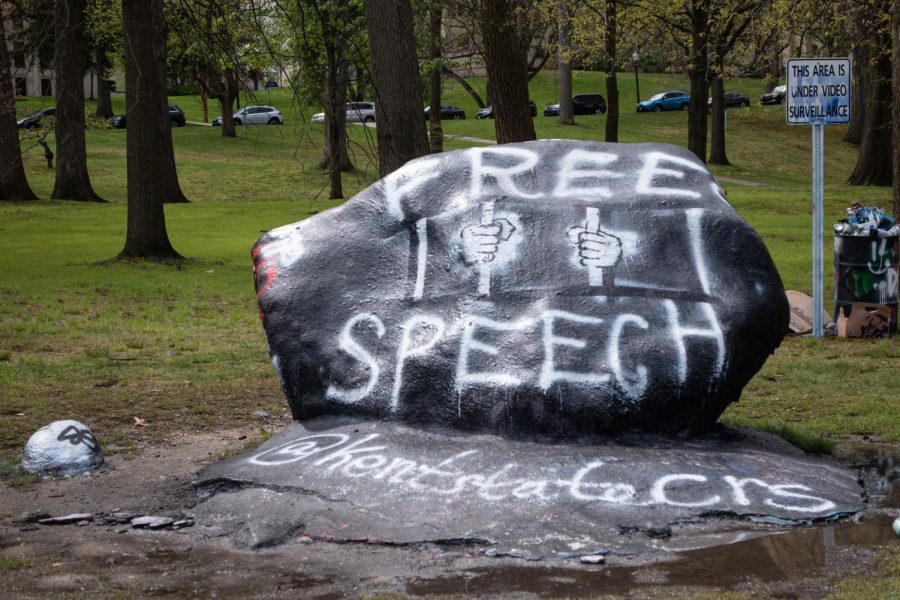Since coming to campus in 1922, The Rock that sits on Hilltop Drive has been a focal point of expression, activism and controversy as students paint messages and images on it.
Recently, discourse between students and university administration regarding what free speech is allowed to be painted on The Rock was questioned.
One member of the Kent State College Republicans, who wanted to remain anonymous to be protected from any potential threats, expressed irritation over their organization’s experience with painting The Rock, and the misinformation they said was spread after repainting their message. This occurred after the College Republicans painted ‘What is a Woman?’ to advertise their showing of Matt Walsh’s documentary.

“We were allowed to go back and paint back over it because that is our allotted time to paint the Rock,” they said. “Then the people that painted over The Rock are saying, ‘Oh, look what they did. They just painted over a trans flag.’”
According to the same member of the organization, The Rock was painted by other individuals six hours after it was originally painted by them. The College Republicans member said their organization respected the regulations of The Rock.
Another campus organization that recently painted The Rock is Kent State Unite for Reproductive and Gender Equity (KSURGE), which hosted a candlelight vigil at The Rock in March in honor of LGBTQ+ hate crime victims.
Riley Hudson, a junior communication studies major and president of KSURGE, said the vigil was hosted specifically for transgender and non-binary community members. This was after the death of Nex Benedict, a non-binary teen from Oklahoma who died from suicide days after a fight with a group of students.
“It was a really positive experience when we all came together and were able to spray paint it,” Hudson said. “We had members of the trans community, the non-binary community, and they spray-painted it because we thought it would be better coming from them.”

Hudson said The Rock provided a perfect opportunity for the organization to publicly show its solidarity and respect for marginalized communities.
“Everyone drives by it all the time,” Hudson said. “It’s such a convenient and easy way to make our purpose known to the community, not just Kent State, but the Kent community, because everyone can see it.”
The Rock is readily available for any university member to paint, which Hudson said can be interpreted as both a positive and a negative.
“It’s easily accessible and convenient, but the downside of that is that people can spew hate,” Hudson said.
In January 2021, a new policy was enacted that states any painting must remain for at least 24 hours on The Rock, and the individuals or organizations behind each painting have to date and time-stamp their work.
Other regulations state it cannot be partially painted, such as painting comments over a previous painting, and no obscene paintings are allowed. Students, faculty and staff drove that conversation of what changes they would like to see implemented.
Taléa Drummer-Ferrell, associate vice president and dean of students for the Division of Student Life, worked to oversee and help students voice what they wanted in the policy.
Drummer-Ferrell said the Black Lives Matter movement in 2020 brought discourse over The Rock and what the restrictions surrounding it should be, regarding free speech. The administration wanted to create rules for The Rock but still honor its original purpose.
“What is it that we are saying the spirit and the energy behind The Rock should be?” Drummer-Ferrell said. “How do we create community standards behind that, but then not make it so restrictive that it loses the whole point of why The Rock is there to begin with?”
Drummer-Ferrell said she believes that despite having newer regulations in place regarding The Rock, it is still a place for students to express what they are passionate about, as Kent State students have a history of doing.
“We have been an institution that believes in the freedom of expression,” Drummer-Ferrell said. “We have leaned into that since our experiences with May 4 in 1970.”
Even when having a civil discourse about controversial topics, Drummer-Ferrell said remembering to have compassion can make the outcome less hurtful and more productive for all of those involved, and that there is a balance to be struck between free speech and respectful dialogue.

“We also understand that when we’re really passionate, we tend to forget the kindness and respect piece, and so my biggest thing is for our students to really lean into that,” Drummer-Ferrell said. “As we continue to move into an area where we will have more controversial topics and we’ll have more difficult conversations, we need to find a way to lean into that kindness and respect.”
Along with occasional controversial paintings, The Rock has remained to be a place for Kent State members to paint for other reasons, such as fraternity or sorority recruitment, club advertisements and birthday celebrations.
“What I hope is that it doesn’t overshadow some of the beauty that this rock has brought to our campus and the things that we have been able to celebrate and honor in a very public way,” Drummer-Ferrell said. “It’s by far one of the coolest things I have seen and it’s beautiful when it’s treated appropriately.”
Kayla Gleason is a beat reporter. Contact her at kgleaso1@kent.edu.










